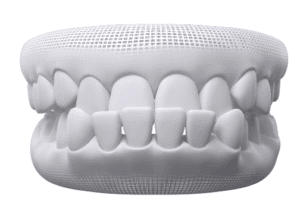Although underbites are less common than other alignment problems like crowding or overjet (i.e., overbites), they often require more complex treatment plans.
Like overjet, an underbite is a type of malocclusion. A “malocclusion” is the clinical term for a bite in which a person’s teeth do not properly align when their jaws are closed. In underbite cases, the lower teeth protrude too far in front of the upper teeth.

When teeth are perfectly aligned, the upper teeth sit just barely outside the lower teeth. In mild underbite cases, the upper teeth are set slightly behind the lower teeth. In more extreme cases, the upper teeth sit fully behind the lower teeth when the jaws are shut tight.
If you’ve been struggling with an underbite, you’ve come to the right place! In this blog, the experts at Beverly Hills Orthodontics answer some of the most common underbite questions, including:
- Do braces fix underbites?
- What are my treatment options?
- How do I know which treatment approach is right for me?
Read on to learn the answers to these questions and more.
Timing is Everything: Treat an Underbite as Early as Possible
 Before we answer “Do braces fix overbites?” and the other questions above, let’s review some important information on underbite treatment as a whole.
Before we answer “Do braces fix overbites?” and the other questions above, let’s review some important information on underbite treatment as a whole.
In general, the earlier you address any orthodontic problem, the better your treatment outcomes will be. Although the American Association of Orthodontists (AAO) recommends that children attend their first orthodontic appointment at age 7, we believe that age 5 is better, especially for underbites.
At age 5, usually around the time the 6-year molars come in, we are able to diagnose burgeoning issues and begin interceptive treatment to correct the problem or at least minimize the severity.
All underbites—from mild to severe—can negatively impact your health in numerous ways, regardless of age. Common effects include:
- Difficulty biting and chewing
- Speech problems
- Greater risk of chipped teeth
- Accelerated tooth wear and decay
- Chronic jaw pain
The BHO Method
At Beverly Hills Orthodontics, we pinpoint potential underbite issues in children by examining contributing factors for every patient, including:
- Jaw size
- Oral bite
- Facial growth patterns
- Permanent tooth eruption patterns
In addition to these measures, we also ask about the patient’s family history. Genetics plays a significant role in underbite development, and family history can reveal important details about how malocclusion may develop over time.
Using these combined details, we develop a treatment plan to permanently correct the underbite at an early age. Children aged 10 and younger respond particularly well to a combination of palatal expanders and reverse pull headgear (RPHG).
Early Treatment Options
Here’s how underbite treatment works in children 10 and under:
-
- A palatal expander is used to widen the patient’s upper jaw and create more space for teeth. Expanding the upper jaw allows us to improve jaw alignment, reduce crowding, and provide teeth with the space they need to grow into their proper positions.
- Reverse pull headgear (RPHG) is an orthodontic appliance that anchors to the patient’s chin and forehead. Usually worn at night, RPHG uses steady pressure to stimulate growth and bring the upper jaw (maxillary) forward. Elastic rubber bands connect the headgear to the child’s molars to pull the upper jaw forward. Over time, the pressure of the elastics also encourages the lower jaw (mandible) to grow down and backward, until the top teeth can rest properly upon the lower jaw. Treatment usually lasts 12 to 14 months.
These treatments are very successful with children because young jawbones are malleable and respond reliably well to pressure. As children age, however, it is harder to predict how effective these approaches will be.
Although expanders and headgear can still benefit patients aged 11-13, appliances may not fix the issue completely. Instead, they may reduce an underbite’s severity enough so that it responds well to other treatments. Beyond age 13, a child’s jawbones are usually too strong for expanders and headgear to make a significant impact on an underbite.
This leads right to our next topic: what underbite treatment looks like for patients over age 13.
Do Braces Fix Underbite? Yes—Usually in Combination With Other Measures
Although underbites respond best to early interceptive treatment, many patients who did not receive childhood orthodontic treatment seek out care later as teenagers or adults. In these cases, orthodontists usually combine braces with additional measures to correct an underbite.
Treatment methods vary according to the severity of the underbite and are influenced by the patient’s anatomy. In mild cases (i.e., jaws are misaligned by less than 3mm), the underbite can be treated with a combination of braces and elastic bands:
- The braces use pressure to move teeth into their proper positions. With underbites, the braces generally move the upper teeth forward so they sit properly upon the lower teeth.
- Elastic bands use pressure to pull upper teeth forward. The elastics are strategically connected to brackets on the lower and upper braces to pull the upper jaw forward continuously until it reaches the correct position.
Camouflage
Many mild cases can also be treated with a procedure called “underbite camouflaging.” Camouflaging is an aesthetic approach to underbite correction. While braces and elastics move jaws into proper alignment, camouflaging helps eliminate the look of an underbite without moving the jaws themselves. In mild cases, camouflaging entails strategically polishing the teeth so that they fit together like a normal bite.
Extraction
![]()
For moderate underbites (5-7mm), we often need to create space within the mouth to properly align teeth and reposition the jaws. Tooth extraction is often the easiest way to produce this space. In most cases, we’ll remove the first premolars, then use braces to eliminate crowding and bring teeth into alignment. Elastics then pull the upper jaw forward to complete the correction.
Surgery
Extraction can also correct some severe underbite cases (over 8mm), but there are times when jaw surgery is the only viable treatment path. While jaw surgery may sound intimidating, it’s often the best option for severe underbites. Surgery also provides numerous benefits, including:
- Significantly improved facial profile
- More effective biting, chewing, and swallowing
- Reduced rates of dental decay and wear
- Clearer speech
- Potentially easier breathing
Of course, there’s only one way to really determine which treatment approach is right for you: by attending a professional orthodontic consultation.
Ready to Improve Your Smile? Contact Beverly Hills Orthodontics Today to Schedule an Appointment
Although underbites are best treated at a young age, using expanders and headgear, braces are a viable way to treat underbites in teenage and adult patients. However, to successfully correct an underbite the braces must be combined with additional methods, including elastics, tooth extraction, or surgery. If you’re ready to begin treating your underbite, Beverly Hills Orthodontics is here to help.
Here at BHO, we use the latest tools and methods to correct all sorts of malocclusions, including underbites. During your consultation, we will work together with you to develop a holistic care plan that honors your schedule and treatment preferences. To get started, contact one of our offices in Beverly Hills, Studio City, Alhambra, our Downtown LA, today.
Do braces fix underbites? They absolutely can—with the help of a licensed orthodontist. Call or text us at (310) 785-0770 or visit our contact page to schedule a free consultation.
